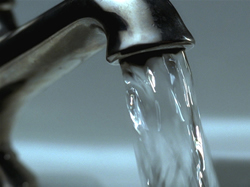October 2, 2006
What’s On Tap With Your Water Supply?
By Michael D. Shaw
Not that you needed any more bad news, but there could be a toxic danger lurking in your home, owing to questionable piping and faucets, affecting your tap water.
Perhaps because the radio waves are full of copper re-piping commercials that stress only the mechanical problems that can occur with outdated piping materials, many people mistakenly believe that as long as water dispenses quickly and looks clear, alternating between hot and cold as the user intends, everything is okay. Unfortunately, even well-performing pipes and fixtures could contain excessive amounts of lead or free copper that are more than a mere nuisance. They could present a significant toxic hazard.
Note that this problem is not confined to homes built several decades ago, when lead pipes were fairly commonplace. Rather, even homes of recent vintage can be affected. The use of lead-based solder for pipe joints, that can deteriorate and leach lead into the water, was not banned until 1988. And, it was not until 1998 that all faucets and plumbing fixtures sold in the U.S. could not contain more than 8% lead—the legal definition of “lead-free” for brass faucets. However, faucets marked with “NSF 61/9” and/or “California Proposition 65” meet stricter limits.
For further information on lead in faucets, visit the website of NSF International (originally called the National Sanitation Foundation).
Though lead poisoning, and its scary effects whereby it accumulates in the body and can cause damage to the brain, red blood cells, and kidneys, is fairly well known, the toxic effects of copper are less extensively publicized. At elevated levels, copper can cause nausea, vomiting, diarrhea, and stomach cramps.
Studies have shown that copper in drinking water can add 4 to 45 percent more of this element to a person’s diet than what would be obtained via food sources alone. You may find that there is a metallic taste in your drinking water before copper levels are high enough to cause adverse health effects. Beyond that, blue-green stains on plumbing fixtures are usually an indication of the presence of copper in drinking water.
Some factors that affect copper in household drinking water are: acidic water (low pH), soft water (low in calcium and magnesium), high residual chlorine levels, long standing time in pipes, and elevated water temperature. If a test shows that you have excessive amounts of lead and/or copper in your water, there are several things you can do to attack the problem.
First, contact your local water utility to ensure that your service line isn’t the cause of the high readings. Corrosion in your pipes, that can exacerbate the situation may be greater if grounding wires from the electrical system are attached to them. By all means, replace any questionable faucets.
Still, some lead problems may persist even if all the common measures are taken. In such a case, you may have to install treatment devices on all fixtures that provide water for drinking or cooking purposes. If you suspect you have lead solder in your plumbing system, you should contact a licensed plumber to remediate the situation.
As to iron in tap water, it is considered more of an aesthetic contaminant, affecting the taste and appearance, rather than producing any detrimental health effect. So-called soluble or clear water iron manifests when a glass of water is allowed to stand, and reddish brown particles will appear in the glass and eventually settle to the bottom. Insoluble iron displays its rusty red or yellow color as soon as it is poured into the glass.
Iron presents one additional challenge as certain bacteria actually consume it, leaving a reddish brown or yellow slime that can clog plumbing and cause an offensive odor. You may notice this slime or sludge in your toilet tank when you remove the lid. The approach to solving an iron problem will depend on whether it is soluble or insoluble, and may include aeration, filtration, ion exchange, and the addition of sequestering agents.
Contaminants in drinking water present a real environmental challenge, and hit you about as close to home as it can get. Be vigilant for tell-tale signs, evaluate your options, test the quality of your drinking water, consult your local utility, and get further professional assistance if needed. Nothing is more basic than pure, safe drinking water.

